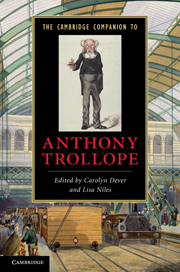Book contents
- Frontmatter
- Introduction
- 1 Trollope’s Literary Life and Times
- 2 Trollope As Autobiographer And Biographer
- 3 Trollope’s Barsetshire Series
- 4 The Palliser Novels
- 5 Trollope Redux: The Later Novels
- 6 Trollope’s Short Fiction
- 7 Trollope And The Sensation Novel
- 8 Queer Trollope
- 9 The hobbledehoy in Trollope
- 10 The construction of masculinities
- 11 Vulgarity and money
- 12 Trollope and the law
- 13 Trollope and travel
- 14 Trollope and the Antipodes
- 15 Trollope and Ireland
- 16 Trollope and America
- Further reading
- Index
- Cambridge Companions to . . .
3 - Trollope’s Barsetshire Series
Published online by Cambridge University Press: 28 March 2011
- Frontmatter
- Introduction
- 1 Trollope’s Literary Life and Times
- 2 Trollope As Autobiographer And Biographer
- 3 Trollope’s Barsetshire Series
- 4 The Palliser Novels
- 5 Trollope Redux: The Later Novels
- 6 Trollope’s Short Fiction
- 7 Trollope And The Sensation Novel
- 8 Queer Trollope
- 9 The hobbledehoy in Trollope
- 10 The construction of masculinities
- 11 Vulgarity and money
- 12 Trollope and the law
- 13 Trollope and travel
- 14 Trollope and the Antipodes
- 15 Trollope and Ireland
- 16 Trollope and America
- Further reading
- Index
- Cambridge Companions to . . .
Summary
At what point did the six novels set in or near Trollope’s fictional county of Barset – The Warden, Barchester Towers, Doctor Thorne, Framley Parsonage, The Small House at Allington, and The Last Chronicle of Barset – become a series? Neither Trollope’s own account, which appears in An Autobiography, nor the critical responses to the first five novels suggests that a series was a planned or an attractive option in the period between the 1855 publication of The Warden and December 1866, when the first episode of The Last Chronicle appeared. While Trollope and his readers viewed Barchester Towers as the “sequel” to The Warden (A ch. 5), Trollope admitted that he did not even invent the plot of Doctor Thorne, that he cast Framley Parsonage near Barset only because a publisher asked for a clerical drama, and that, when he did begin to imagine a series, he was not sure that Doctor Thorne or The Small House at Allington belonged in it. Those reviewers who commented on the repetitions within the novels did not typically welcome what they saw as Trollope’s “habit” of “borrowing from himself”; most frequently, they viewed this as a “weakness” that betrayed “a great poverty of invention” on the part of the author (Crit. Her. 131, 123, 134).
- Type
- Chapter
- Information
- The Cambridge Companion to Anthony Trollope , pp. 31 - 43Publisher: Cambridge University PressPrint publication year: 2010
- 3
- Cited by

